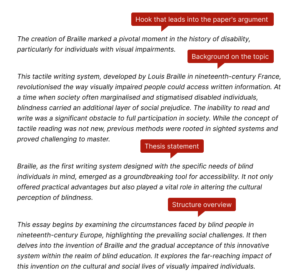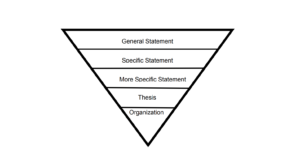Writing an essay introduction is simple but not always easy. Though the objective of your introduction is to offer readers a clear picture of what your writing will be about, it can go much beyond that.
A powerful introduction captures the reader’s attention and sets the stage for the entire work. Some professors might even base their grading decisions on your introduction paragraph. So, if you want to produce an essay that stands out, you need to start strong.
In this article, we will explain how to begin an essay and share expert tips to help you get your introduction right every single time, but let’s start with the basics first.
Primary objectives of an introduction paragraph
Typically, an essay introduction has three primary objectives:
- Give background on the topic.
- Present the central point of the essay — your thesis statement.
- Describe the organisation and structure of your paper.
Here’s one of the excellent introduction essay examples that is definitely worthy of your attention:

General structure of an essay introduction
There are numerous examples of how introduction paragraphs can be written, what they should contain and how they should be formatted. However, we recommend sticking with the triangle model, the most commonly employed structure when writing for academic purposes. This method uses a deductive structure to present the introduction and looks this way:

Key components of an essay introduction paragraph
A good essay introduction usually includes four main components:
1. General Statement
The general statement is a broad statement that introduces the overall topic of the work.
2. Specific & More Specific Statements
These begin by giving the reader the necessary background information needed to comprehend the topic and the broader context in which the paper fits. When writing this section of your essay, it is recommended that you introduce only some of the most relevant material without going into much detail. Also, you can define a problem your essay attempts to solve (if applicable to the paper’s purpose).
3. Thesis
Your thesis is the critical point that will be supported in the essay’s body. Its format will differ based on the type of essay you are writing. When working on this part of introduction for essay, use the thesis statement to ensure that the content in the paper’s body backs up the assertions made.
4. Organisation
This is the final component of the introduction paragraph that outlines the structure of your paper and gives the reader an overall idea of how it will be laid out and what topics will be covered. While this component may be skipped depending on the length and nature of the work, it is extremely helpful when writing large, complex papers that have multiple sections.
Read also: Why hire a custom essay writing service?
The usual length of an introduction
A general rule of thumb suggests that an introduction paragraph should be approximately 10% of the paper’s word count. With this in mind, we can conclude that the ideal length of an introduction to an average essay of up to four pages long will be one well-developed paragraph, occupying half to three-quarters of the first page. At the same time, a twenty-page paper will call for a two-page intro. Of course, this may vary depending on how detailed your essay is and what you write about, so always check the professor’s instructions first.
Now that you know the objectives, structure, key components and other essentials of a powerful essay introduction, let’s discuss the best ways to start an essay.
How to open an essay in an effective way
There are different ways to start an essay. Each has pros and cons, and each is suited for specific types of essays. Although these openings employ different rhetorical devices and hook the reader differently, they all serve the same goal: to captivate the reader’s attention and make them want to know more.
Unfortunately, there’s no specific formula for writing the essay’s opening part, and an introduction that successfully hooks a reader in one essay won’t necessarily be effective in another paper. Still, there are some proven ways to write an engaging hook. They are as follows:
1. Open your essay by asking a question.
One of the most effective ways to start an essay, especially a persuasive one, is with a question. When you ask a question, the reader will tend to interact with your work and can even pick a side. Make it a question that requires the reader to read more of the paper to get an answer. For instance, “Do you wish to discover the secrets of writing an A-grade essay?” Interested students will undoubtedly continue reading to learn more.
On the other hand, you can start your essay with a rhetorical question such as “What would the world look like if humans never existed?” Using a rhetorical question might get your readers to reflect on the work and show them where you’re going with your essay.
2. Starting an essay with a quote.
Opening your essay with a memorable quote is another way to go, especially if it’s from someone influential (but be sure to introduce them first). However, ensure that the quote is relevant to your essay’s topic.
Avoid overused cliches as they lack the element of surprise. Similarly, don’t use complicated quotes that your readers will be unable to grasp or relate to. Instead, look for quotes from credible sources and explain them in a way that supports the thesis statement.
3. Kick it off with storytelling.
The next way to hook your reader is to share an interesting story or personal narrative. Set the stage for your story with an inviting description that includes the who, where, when and what, and you’re halfway to success!
If you’re writing a descriptive or creative essay, you can also add sensory elements like what you feel with your touch or smell to engage your readers further. Just remember to keep your story short and to the point. Though your readers might enjoy a great story, extended narratives can consume a significant portion of your paper’s word count, making it a real headache to fit the length requirements.
4. Share statistics, numbers or an amusing fact.
Quoting statistics, numbers, or shocking facts from related research and studies can be an excellent way to open an essay, too. This piques the reader’s interest and makes them want to read on, anticipating clarification or elaboration on the data you presented. For instance, “Do you know that over one-third of adults choose to sleep with a comfort object?”.
This is only one of the startling instances, but using numbers and statistics is a simple approach to show readers the big picture of the case. In other words, how serious or important it is.
5. Reveal a common misconception.
Another good way to start an essay is to reveal a common misconception that can pique the reader’s interest in discovering more. For instance, “The Chinese didn’t invent fortune cookies!”.
The thing is, we can’t help but be intrigued when a statement shows a discrepancy between our beliefs and reality. So, if your topic concerns a standard view that’s totally wrong, use this as a chance to craft an engaging hook.
6. Use a riddle or joke.
Last but not least, one of the most difficult but definitely most effective ways to begin an essay is with a riddle or joke. Your readers will likely smile and feel great about your writing if you include a clever joke or riddle in the introduction paragraph.
The best way to find a topic-relevant joke is to do a web search with the word “joke.” However, when doing this, make sure that your readers can relate to it or find it funny, or else it will most likely appear awkward or confusing.
Do’s and dont’s of writing a winning introduction paragraph
As you now know how to start essay and have specific examples to help you get going, your next step is understanding what you should and shouldn’t do while writing an essay introduction. Let’s take a quick look below:
Dos
- Keep the paper’s purpose in mind and ensure it meets the professor’s requirements.
- Make certain that readers understand your perspective.
- Demonstrate your expertise in the topic.
- Provide a roadmap to help readers comprehend what you discuss throughout the essay.
- Use topic sentences.
- Use words that demonstrate a structured, logical approach to the question.
- Echo the language used in your question.
- Raise your topic in your very first sentences.
- Give some background information necessary for understanding the issue.
- Construct a strong thesis statement.
- Create intrigue.
- Make sure there’s a smooth transition from your opening to the essay’s body.
Dont’s
- Sink too much time into the introduction.
- Begin too broadly.
- Provide dictionary definitions of words.
- Employ sweeping generalisations.
- Use off-topic sentences.
- Make your opening paragraph long.
- Repeat the paper’s specifications using the professor’s wording.
- Give in-depth explanations that belong in the body paragraphs.
- Use quotation marks excessively.
If you are still wondering what is a good way to start an essay, keep in mind that you can always hire an essay writer at royalessays.org and get professional assistance with anything from the opening part to the entire paper on any topic. Our subject-matter experts have years of expertise in writing different types of essays for high school, college and university students, and they are here to assist you 24/7!

